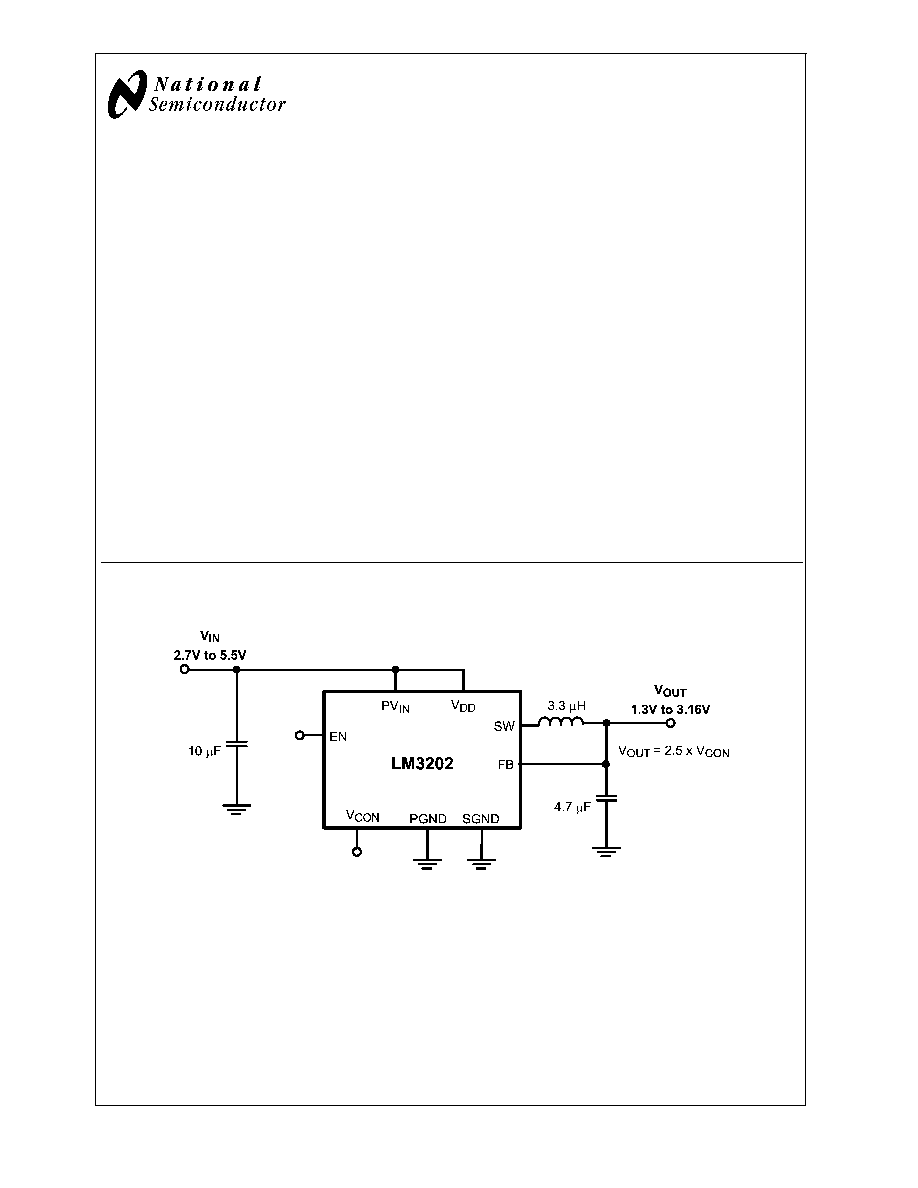
LM3202
650mA Miniature, Adjustable, Step-Down DC-DC
Converter for RF Power Amplifiers
General Description
The LM3202 is a DC-DC converter optimized for powering
RF power amplifiers (PAs) from a single Lithium-Ion cell,
however they may be used in many other applications. It
steps down an input voltage from 2.7V to 5.5V to a variable
output voltage from 1.3V to 3.16V. Output voltage is set
using a V
CON
analog input for controlling power levels and
efficiency of the RF PA.
The LM3202 offers superior performance for mobile phones
and similar RF PA applications. Fixed-frequency PWM op-
eration minimizes RF interference. Shutdown function turns
the device off and reduces battery consumption to 0.01 �A
(typ.).
The LM3202 is available in a 8-pin lead free micro SMD
package. A high switching frequency (2 MHz) allows use of
tiny surface-mount components. Only three small external
surface-mount components, an inductor and two ceramic
capacitors are required.
Features
n
2 MHz (typ.) PWM Switching Frequency
n
Operates from a single Li-Ion cell (2.7V to 5.5V)
n
Variable Output Voltage (1.3V to 3.16V)
n
Fast Output Voltage Transient (1.3V to 3.16V in 20�s)
n
650mA Maximum load capability
n
High Efficiency (96% Typ at 3.6V
IN
, 3.16V
OUT
at 400mA)
from internal synchronous rectification
n
8-pin micro SMD Package
n
Current Overload Protection
n
Thermal Overload Protection
n
Soft Start function
Applications
n
Cellular Phones
n
Hand-Held Radios
n
RF PC Cards
n
Battery Powered RF Devices
Typical Application
20141501
FIGURE 1. LM3202 Typical Application
October 2005
LM3202
650mA
Miniature,
Adjustable,
Step-Down
DC-DC
Converter
for
RF
Power
Amplifiers
� 2005 National Semiconductor Corporation
DS201415
www.national.com
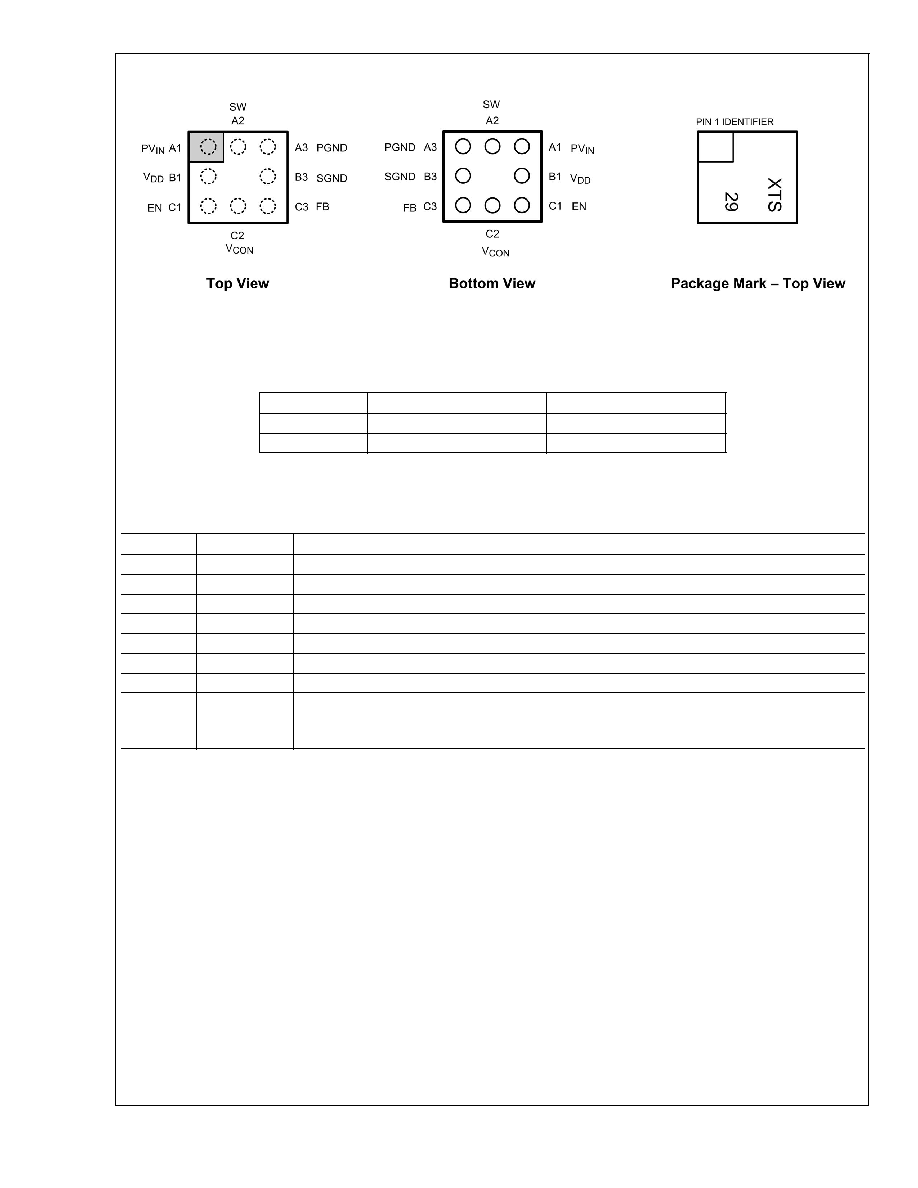
Connection Diagrams
20141599
8�Bump Thin Micro SMD Package, Large Bump
NS Package Number TLA08GNA
Order Information
Order Number
Package Marking (Note)
Supplied As
LM3202TL
XTS/29
250 units, Tape-and-Reel
LM3202TLX
XTS/29
3000 units, Tape-and-Reel
Note: The actual physical placement of the package marking will vary from part to part. The package marking "X" designates the date
code. "T" is a NSC internal code for die traceability. "S" designates the device type as switcher device. Both will vary considerably. "29"
identifies the device (part number, option, etc.).
Pin Descriptions
Pin #
Name
Description
A1
PV
IN
Power Supply Voltage Input to the internal PFET switch.
B1
V
DD
Analog Supply Input.
C1
EN
Enable Input. Set this digital input high for normal operation. For shutdown, set low.
C2
V
CON
Voltage Control Analog input. V
CON
controls V
OUT
in PWM mode.
C3
FB
Feedback Analog Input. Connect to the output at the output filter capacitor.
B3
SGND
Analog and Control Ground
A3
PGND
Power Ground
A2
SW
Switch node connection to the internal PFET switch and NFET synchronous rectifier.
Connect to an inductor with a saturation current rating that exceeds the maximum Switch Peak
Current Limit specification of the LM3202.
LM3202
www.national.com
2
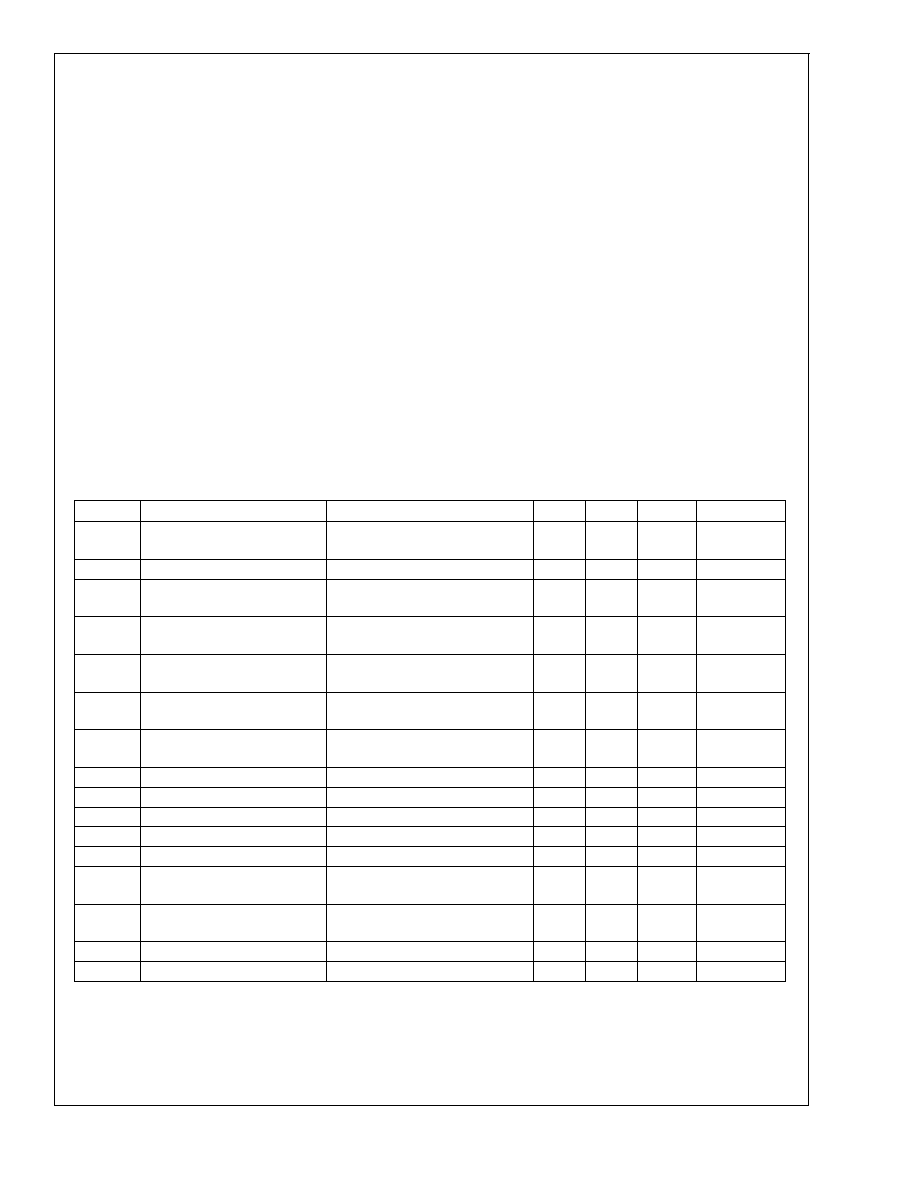
Absolute Maximum Ratings
(Notes 1, 2)
If Military/Aerospace specified devices are required,
please contact the National Semiconductor Sales Office/
Distributors for availability and specifications.
V
DD
, PV
IN
to SGND
-0.2V to +6.0V
PGND to SGND
-0.2V to +0.2V
EN, FB, V
CON
(SGND -0.2V)
to (V
DD
+0.2V)
w/6.0V max
SW
(PGND -0.2V)
to (PV
IN
+0.2V)
w/6.0V max
PV
IN
to V
DD
-0.2V to +0.2V
Continuous Power Dissipation
(Note 3)
Internally Limited
Junction Temperature (T
J-MAX
)
+150�C
Storage Temperature Range
-65�C to +150�C
Maximum Lead Temperature
(Soldering, 10 sec)
+260�C
ESD Rating (Notes 4, 13)
Human Body Model:
Machine Model:
2 kV
200V
Operating Ratings
(Notes 1, 2)
Input Voltage Range
2.7V to 5.5V
Recommended Load Current
0mA to 650mA
Junction Temperature (T
J
) Range
-30�C to +125�C
Ambient Temperature (T
A
) Range
(Note 5)
-30�C to +85�C
Thermal Properties
Junction-to-Ambient Thermal
100�C/W
Resistance (
JA
), TLA08 Package
(Note 6)
Electrical Characteristics
(Notes 2, 7, 8) Limits in standard typeface are for T
A
= T
J
= 25�C. Limits in bold-
face type apply over the full operating ambient temperature range (-30�C
T
A
= T
J
+85�C). Unless otherwise noted, all
specifications apply to LM3202 with: PV
IN
= V
DD
= EN = 3.6V.
Symbol
Parameter
Conditions
Min
Typ
Max
Units
V
FB, MIN
Feedback Voltage at minimum
setting
V
CON
= 0.4V(Note 8)
1.21
1.30
1.39
V
V
FB
Feedback Voltage
V
CON
= 1.1V(Note 8)
2.693
2.75
2.835
V
V
FB, MAX
Feedback Voltage at maximum
setting
V
CON
= 1.4V(Note 8)
3.03
3.17
3.29
V
I
SHDN
Shutdown supply current
EN = SW = V
CON
= 0V,
(Note 9)
0.01
2
�A
I
Q
DC bias current into V
DD
V
CON
= 1V, FB = 0V,
No Switching (Note 10)
1
1.4
mA
R
DSON(P)
Pin-pin resistance for PFET
I
SW
= 200mA
140
200
230
m
R
DSON(N)
Pin-pin resistance for NFET
I
SW
= -200mA
300
415
485
m
I
LIM,PFET
Switch peak current limit
(Note 11)
935
1100
1200
mA
F
OSC
Internal oscillator frequency
1.7
2
2.3
MHz
V
IH,EN
Logic high input threshold
1.2
V
V
IL,EN
Logic low input threshold
0.5
V
I
PIN,ENABLE
Pin pull down current
5
10
�A
V
CON,MIN
V
CON
Threshold
Commanding V
FB,MIN
V
CON
swept down(Note 8)
0.484
0.52
0.556
V
V
CON,MAX
V
CON
Threshold
Commanding V
FB,MAX
V
CON
swept up(Note 8)
1.208
1.27
1.312
V
Z
CON
V
CON
input resistance
100
k
Gain
V
CON
to V
OUT
Gain
0.556V
V
CON
1.208V
2.5
V/V
LM3202
www.national.com
3
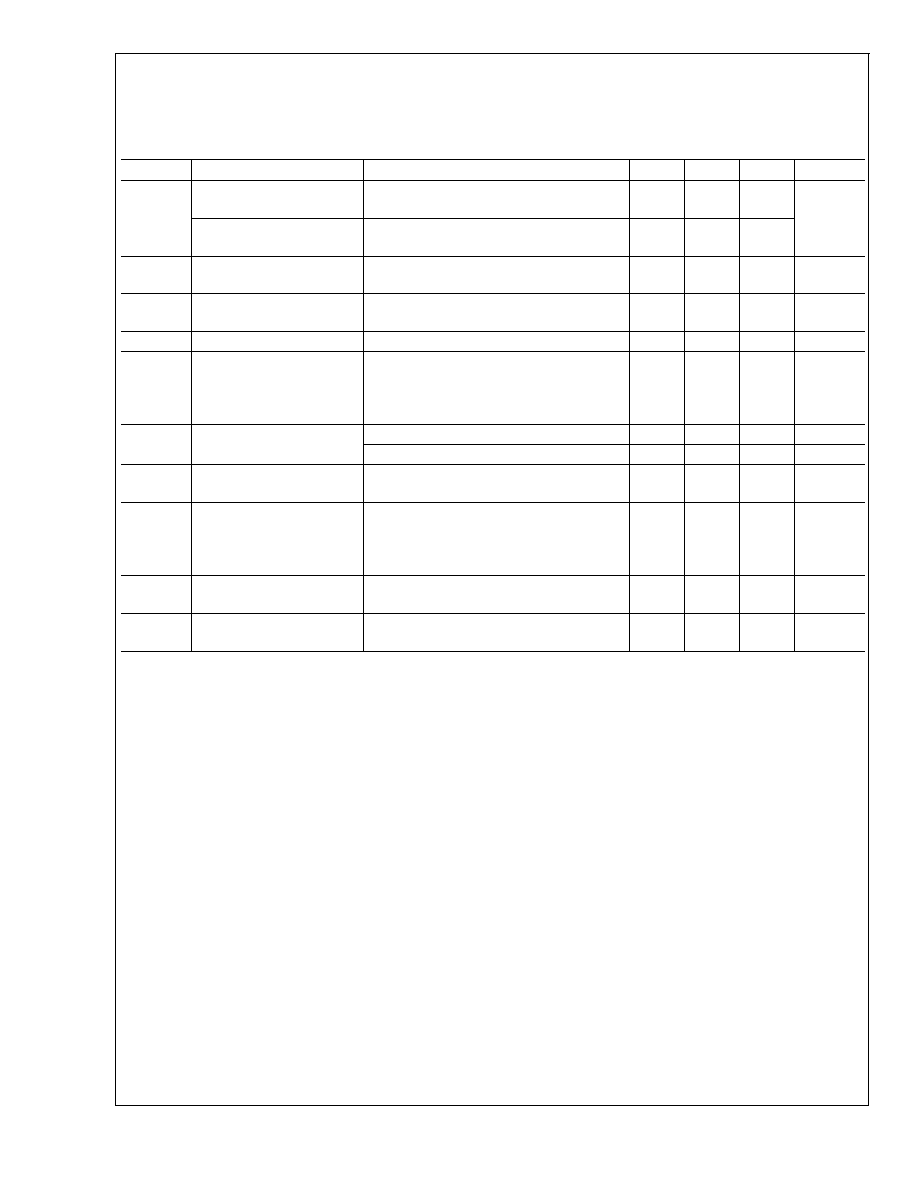
System Characteristics
The following spec table entries are guaranteed by design providing the component
values in the typical application circuit are used. These parameters are not guaranteed by production testing. Min and
Max limits apply over the full operating ambient temperature range (-30�C
T
A
85�C) and over the V
IN
range = 2.7V to
5.5V unless otherwise specified, Typical values are at T
A
= 25�C, PV
IN
= V
DD
= EN = 3.6V unless otherwise specified, L =
3.3�H, DCR of L
100m, C
IN
= 10�F, 0603, 6.3V (4.7�F||4.7�F, 0603, 6.3V can also be used), C
OUT
= 4.7�F, 0603, 6.3V
Symbol
Parameter
Conditions
Min
Typ
Max
Units
T
RESPONSE
Time for V
OUT
to rise from
1.3V to 3.16V
V
IN
= 4.2V, C
OUT
= 4.7�F, L = 3.3�H,
R
LOAD
= 5
20
30
�s
Time for V
OUT
to fall from
3.16V to 1.3V
V
IN
= 4.2V, C
OUT
= 4.7�F, L = 3.3�H,
R
LOAD
= 10
20
30
C
CON
V
CON
input capacitance
V
CON
= 1V,
Test frequency = 100 kHz
20
pF
Linearity
Linearity in control
range 0.556V to 1.208V
V
IN
= 3.6V
Monotonic in nature
-3
+3
%
I
CON
Control pin input current
-10
10
�A
T
_ON
Turn on time
(time for output to reach
3.16V from Enable low to
high transition)
EN = Low to High, V
IN
= 4.2V, V
O
= 3.16V,
C
OUT
= 4.7�F, I
OUT
1mA
210
750
�s
Efficiency
(L = 3.3�H, DCR
100m)
V
IN
= 3.6V, V
OUT
= 1.3V, I
OUT
= 90mA
87
%
V
IN
= 3.6V, V
OUT
= 3.16V, I
OUT
= 400mA
96
%
V
OUT
_ripple Ripple voltage, PWM mode
V
IN
= 3V to 4.5V, V
OUT
= 1.3V, I
OUT
= 10mA
to 400mA (Note 12)
10
mVp-p
Line_tr
Line transient response
V
IN
= 600mV perturbance, over Vin range 3V
to 5.5V
T
RISE
= T
FALL
= 10�s, V
OUT
= 1.3V, I
OUT
=
100mA
50
mVpk
Load_tr
Load transient response
V
IN
= 3.1/3.6/4.5V, V
OUT
= 1.3V, transients
up to 100mA, T
RISE
= T
FALL
= 10�s
50
mVpk
PSRR
V
IN
= 3.6V, V
OUT
= 1.3V,
I
OUT
= 100mA
sine wave perturbation
frequency = 10kHz, amplitude = 100mVp-p
40
dB
Note 1: Absolute Maximum Ratings indicate limits beyond which damage to the component may occur. Operating Ratings are conditions under which operation of
the device is guaranteed. Operating Ratings do not imply guaranteed performance limits. For guaranteed performance limits and associated test conditions, see the
Electrical Characteristics tables.
Note 2: All voltages are with respect to the potential at the GND pins. The LM3202 is designed for mobile phone applications where turn-on after power-up is
controlled by the system controller and where requirements for a small package size overrule increased die size for internal Under Voltage Lock-Out (UVLO) circuitry.
Thus, it should be kept in shutdown by holding the EN pin low until the input voltage exceeds 2.7V.
Note 3: Internal thermal shutdown circuitry protects the device from permanent damage. Thermal shutdown engages at T
J
= 150�C (typ.) and disengages at T
J
=
130�C (typ.).
Note 4: The Human body model is a 100pF capacitor discharged through a 1.5k
resistor into each pin. (MIL-STD-883 3015.7) The machine model is a 200pF
capacitor discharged directly into each pin.
Note 5: In applications where high power dissipation and/or poor package thermal resistance is present, the maximum ambient temperature may have to be
de-rated. Maximum ambient temperature (T
A-MAX
) is dependent on the maximum operating junction temperature (T
J-MAX-OP
= 125�C), the maximum power
dissipation of the device in the application (P
D-MAX
), and the junction-to ambient thermal resistance of the part/package in the application (
JA
), as given by the
following equation: T
A-MAX
= T
J-MAX-OP
� (
JA
x P
D-MAX
).
Note 6: Junction-to-ambient thermal resistance (
JA
) is taken from thermal measurements, performed under the conditions and guidelines set forth in the JEDEC
standard JESD51-7. A 4 layer, 4" x 4", 2/1/1/2 oz. Cu board as per JEDEC standards is used for the measurements.
Note 7: Min and Max limits are guaranteed by design, test, or statistical analysis. Typical numbers are not guaranteed, but do represent the most likely norm. Due
to the pulsed nature of the testing T
A
= T
J
for the electrical characteristics table.
Note 8: The parameters in the electrical characteristics table are tested under open loop conditions at PV
IN
= V
DD
= 3.6V. For performance over the input voltage
range and closed loop results refer to the datasheet curves.
Note 9: Shutdown current includes leakage current of PFET.
Note 10: I
Q
specified here is when the part is operating at 100% duty cycle.
Note 11: Current limit is built-in, fixed, and not adjustable. Refer to datasheet curves for closed loop data and its variation with regards to supply voltage and
temperature. Electrical Characteristic table reflects open loop data (FB = 0V and current drawn from SW pin ramped up until cycle by cycle limit is activated). Closed
loop current limit is the peak inductor current measured in the application circuit by increasing output current until output voltage drops by 10%.
Note 12: Ripple voltage should measured at C
OUT
electrode on good layout PC board and under condition using suggested inductors and capacitors.
Note 13: National Semiconductor recommends that all integrated circuits be handled with appropriate precautions. Failure to observe proper ESD handling
techniques can result in damage.
LM3202
www.national.com
4
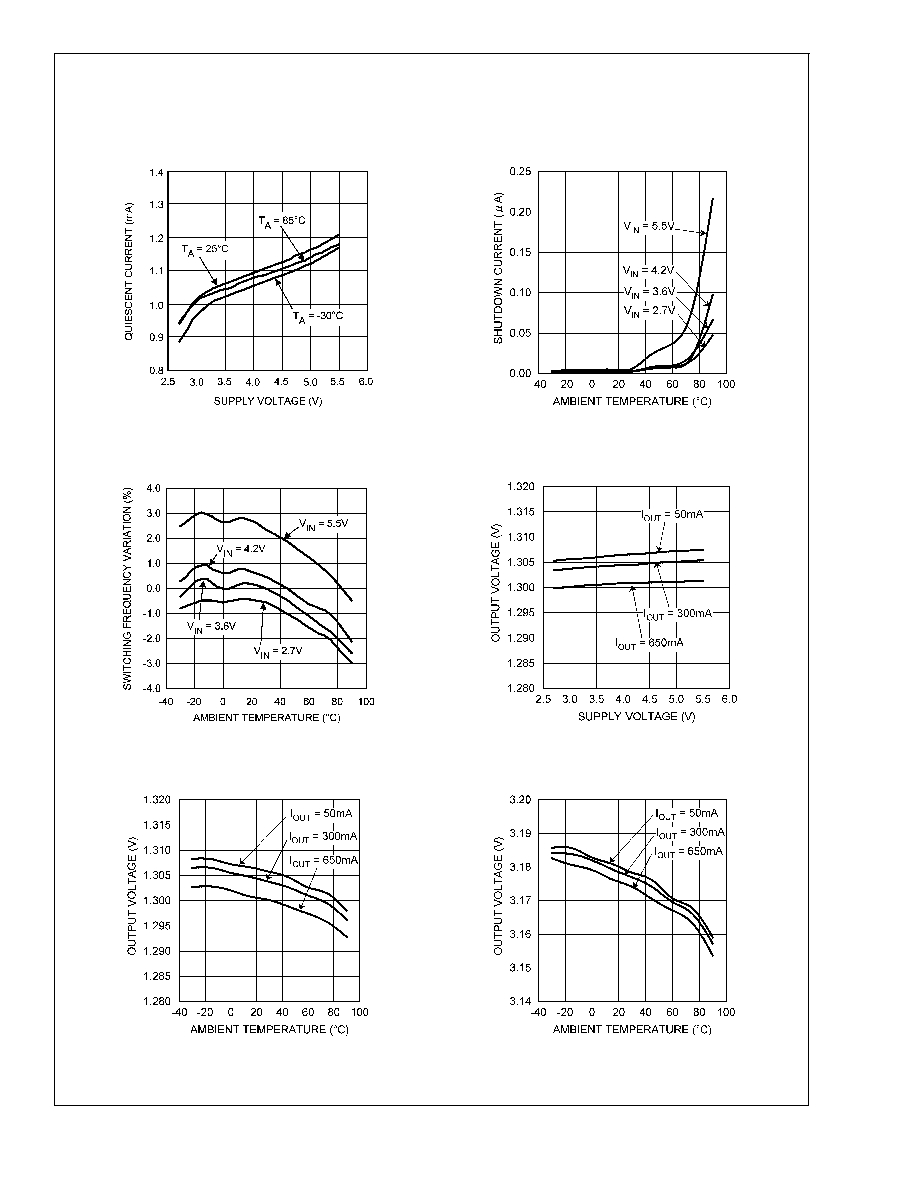
Typical Performance Characteristics
(Circuit in Figure 3, PV
IN
= V
DD
= EN = 3.6V, L = 3.3uH, DCR
of L
100m, C
IN
= 10uF, 0603, 6.3V ( 4.7uF||4.7uF, 0603, 6.3V can be used), C
OUT
= 4.7uF, 0603, 6.3V unless otherwise
noted)
Quiescent Current vs Supply Voltage
(V
CON
= 2V, FB = 0V, No Switching)
Shutdown Current vs Temperature
(V
CON
= 0V, EN = 0V)
20141557
20141556
Switching Frequency Variation vs Temperature
(V
OUT
= 1.3V, I
OUT
= 200mA)
Output Voltage vs Supply Voltage
(V
OUT
= 1.3V: low clamp)
20141555
20141558
Output Voltage vs Temperature
(V
IN
= 3.6V, V
OUT
= 1.3V: low clamp)
Output Voltage vs Temperature
(V
IN
= 3.6V, V
OUT
= 3.16V: high clamp)
20141559
20141510
LM3202
www.national.com
5




